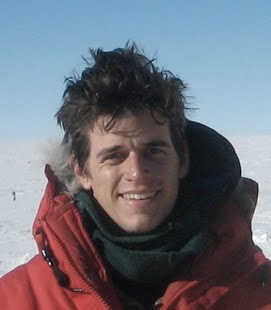
The South Pole Telescope doesn’t look at the kind of light that’s visible to human eyes; it looks at microwave light with wavelengths of a few mm. If you go outside at night and look up at the stars, what you mostly see isn’t stars but black, empty space. If instead you went outside with beach-ball-sized microwave eyes and looked up, the whole sky would be glowing with light. This light was released very early in the universe’s history and is known as the “Cosmic Microwave Background” or “CMB”. Amazingly, careful study of this light has allowed cosmologists to measure the age of the universe (13.7 billion years) and what it is made of (4% normal matter, like what you and I and stars are made of; 22% dark matter, a type of matter that doesn’t interact with light and is thus dark; and 74% dark energy, a completely strange and poorly understood force that is causing the universe’s expansion to accelerate).
The first big goal of the South Pole Telescope is to get a better handle on this mysterious dark energy. Here’s a breakdown of how this will happen:
- Stars are grouped into galaxies. Our Sun is only 1 out of the 100 billion stars in our galaxy, the Milky Way.
- Galaxies themselves are grouped into massive clumps of galaxies known as galaxy clusters. These are the largest gravitationally bound objects in the universe. (“galaxy cluster” is a misnomer; these things are essentially big globs of dark matter with a sprinkling of galaxies tossed in).
- The Cosmic Microwave Background acts as a backlight to these galaxy clusters. That is, the galaxy cluster distorts the CMB, and observing this distortion allows you to see the galaxy cluster.
- The SPT will employ this method to hopefully discover 1000’s of new galaxy clusters.
- A careful analysis of these galaxy clusters will allow us to learn a lot about how and when dark energy came to dominate our universe.
If that last sentence is a little unclear, here is some further explanation:
The universe began as a much simpler place than the one we see today. Whereas the current universe contains a rich structure of stars, galaxies, and galaxy clusters, the early universe was a soup of smoothly distributed matter. How did the smooth, early universe become the clumpy universe of today? The answer is gravity. Gravity makes matter collapse upon itself. In fact, because there is a lot more dark matter than normal matter (remember from above: 22% vs 4%), the main structures in the universe are dark; all the stars and galaxies you’ve ever seen pictures of are just along for the ride.
So dark matter (along with gravity) causes the growth of structure in the universe. As it turns out, dark energy inhibits the growth of structure. It’s actually a very simple battle between the two; dark matter is trying to pull stuff together (--> <--), and dark energy is trying to blow stuff apart (<-- -->). Now, this is where the South Pole Telescope comes back into the picture. By discovering 1000’s of new galaxy clusters, the SPT will catalog the history of structure formation in the universe. This, in turn, will allow us to study the battle between dark matter and dark energy, and to see how and when dark energy came to dominate the battle, as it is believed to do.
Hopefully we'll begin to probe this exciting science when we finish the telescope in about a month. It should be a thrilling year!

5 comments:
so who's side are you on?
the smart money is on dark energy. all knowledge points to dark energy being the dominant form of energy in our universe right now AND for the rest of time...
umm.. is it cold there :) ?
Yea, it's pretty cold here. A typical day is -25F (-30C). Somehow your body recalibrates, and these temperatures become no big deal.
ok, that sounds very interesting, I've read already about dark energy in one astronomy book (I can't remember the author xD), anyway, can't wait to hear the results of the telescope's work! =8)
Post a Comment